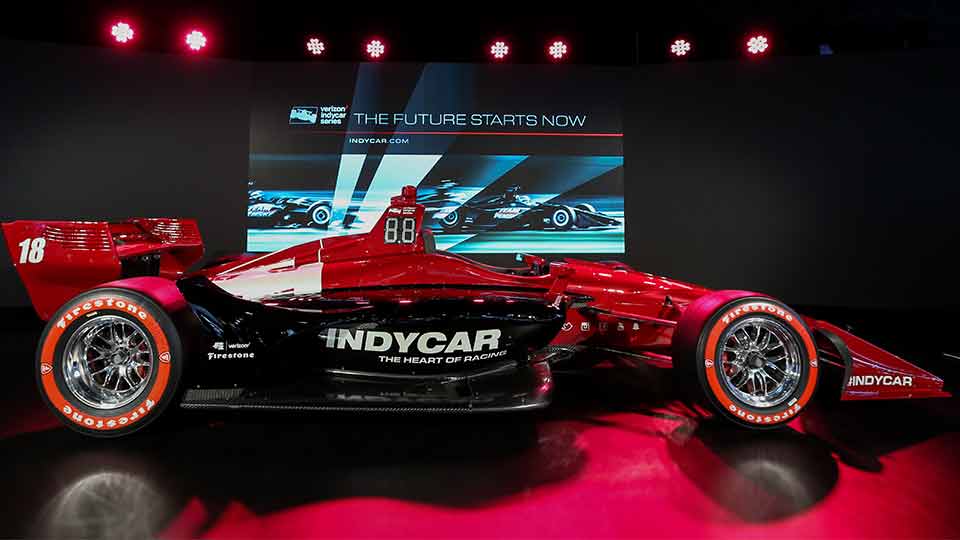We get it, there are a lot of new terms that are used in racing, some you may have never heard before. We break down these terms so the next time you watch a race you can follow along and maybe teach your friends and family.
Accelerometer: An accelerometer is a device that measures the acceleration of an object. In the case of IndyCar, it sits in a driver's earpiece and it measures the forces a driver’s head experiences in an impact.
Adhesion: The maintenance of contact between two touching objects. Adhesion refers to a static condition, whereas traction (also known as "grip") refers to a moving condition. Adhesion in racing often consists of the contact between the tires and the tracks. If the track is dry, the adhesion forces will be stronger than if the track is wet.
Aerodynamics: As applied to racing, it is the study of the interaction between air and the resistance and pressures created by the a car moving through the air. The goal in racing is for teams to use aerodynamics to try and maximize the force pushing down on the car and keeping it on the track (downforce, which we will get to later), as well as minimizing the drag that acts to slow the car. The new Aerodynamic Bodywork Kits (Aero Kits for short) are supplied by Chevrolet or Honda and are attached to the body of the car to try and achieve the quickest possible lap times.
Apex: The area of a turn near its geometric center. Hitting the apex allows the driver to take the straightest line as well as maintain the highest possible speed through the corner.
Apron: The paved (and usually flat) portion of a racetrack that separates the racing surface from the infield. Generally, a concrete wall, steel guardrail or SAFER Barrier separates the apron from the infield.
Blister: Bubbles on the surface of a tire created by overheating of the tread compound. The excess heat can cause the rubber to soften and break away from the surface of the tire.
Camber: The angle at which the tires sit relative to the road. On an oval course, it is the degree to which right-side tires lean in toward the car (from the top of the tire) and the left-side tires lean out. Camber is used to increase the portion of the tire that makes contact with the track (contact patch), which increases the grip. The body of the car rolls due to the force of the turn so the camber helps to maintain tire-to-track contact.
Camshaft: A rotating shaft in the engine that lets air and fuel into the engine and the exhaust out of the engine. This is done through the opening and closing of the engine’s intake and exhaust valves. .
Crankshaft: The rotating shaft within the engine that is turned by the up-and-down motion of the pistons. The crankshaft transfers power to the flywheel (where it is converted into torque), and in turn to the transmission.
Disc: The rotor or the part of the brakes which revolves. This is the part that the brake linings are pressed against during braking. Friction reduces the rotational energy causing the car to slow down, and converts this energy to waste heat.
Downforce: Creation of force through aerodynamics, which keeps the car stuck to the track. The wings on the car force it to stay on the ground, acting in a manner opposite to the wings of an airplane, which create lift. The rear wings on the car are responsible for the majority of the downforce, when compared with the front wings.
Dyno: Short for “dynamometer,” a static machine used to measure an engine’s force, torque or power output. In the case of IndyCar, it is used to measure the engine's horsepower output.
Ethanol: Alcohol derived primarily from grain, it is the same type of alcohol that is found in alcoholic beverages. It is a clean-burning and renewable fuel that is nontoxic and 100 percent biodegradable. IndyCar Series cars use a blend of 85 percent ethanol and 15 percent gasoline (Sunoco E85R).
"European-style" qualifying: Timed session in which all cars run on the track at the same time to post the quickest lap. Used in Verizon IndyCar Series road/street qualifications. Single car qualifying is still used in the Indy 500 and on oval tracks.
Groove/Line: The fastest or most efficient way around the racetrack. Most drivers will try to use the same groove around the racetrack. The groove will start to appear darker in color than the rest of the track because of the build-up of tire rubber that the tires leave behind.
Loose: Term used to describe that rear of the car is unstable because of a lack of rear-tire grip caused by too much front or not enough rear downforce. The force on the front wheels causes the car to turn more than the driver intended (oversteer).
Marbles: Excess rubber build-up above the groove on the track, the result of normal tire wear throughout the race. A car that drives through marbles will lose grip and can slip and slide on the track.
Paddle Shift System: A pneumatic (and clutchless) gearshift system that allows the driver to keep both hands on the steering wheel during shifting by using paddles located on the back of the steering wheel to shift up and down. The paddle shift system has its own control unit that is in sync with the engine, so it knows what gear the driver is in, engine RPMs and the speed of the car.
Pushing: The car does not want to turn in the corners because of a lack of front tire grip. This can be caused by a lack of downforce on the front of the car or too much downforce on the rear of the car. The force on the back wheels prevents the car from turning as much as the driver wants it to (understeer).
Ride height: The distance from the lowest part of the car (not meant to be in contact with the ground already) to the ground when a car is at speed. Indycar rules stipulate that the ride height of the sides of a car should be 2 inches off the ground for all tracks. A lower ride height leads to increased handling.
Short track: Racetracks that are 1 mile (1.6 km) or less in length. In comparison, a Superspeedway is an oval track that is 1.5 miles (2.4 km) in length or more.
Slicks: A treadless tire, used only on dry surfaces. Slicks provide maximum contact with the track surface by eliminating the tread, which enhances grip. In wet conditions, treaded tires are used in order to increase grip.
Telemetry: A radio device that relays information such as engine, tire, steering and throttle performance from the car on the track to the engineers on pit lane. The team can monitor both car and driver activity to ensure the car is performing properly. It helps the team to notice any mechanical issues that may arise with the car during the race.
Tight: Also known as "understeer." A handling condition characterized by a lack of grip in the front tires. As the driver steers through a turn, the front wheels want to continue straight.
Toe: Refers to the alignment of the front and rear tires relative to the center of the car. If tires point inward, the condition is called "toe-in." If tires point outward, the condition is called "toe-out." Correct toe settings are essential in order to maximize grip. Toe-in causes the car to tend to drive in a straight line, making turning more difficult. Toe-out will make the car more sensitive to directional changes, making turns with less movement on the steering wheel.
Tow/drafting: As the race car moves around the track, it splits the air, some going over the car and some beneath. This lack of air behind the car creates a vacuum, which a trailing car may use to be pulled toward the leading car, closing the gap between the two cars in the hopes of overtaking the lead car.
Turbocharger: Increases an engine's efficiency and power output by forcing extra air into the combustion chamber. Engine exhaust gases are routed to turn a turbine, which powers a compressor that forces a greater volume of air into the engine’s intake system, compared to atmospheric pressure alone.
Variable Ratio Steering Rack: The primary steering mechanism of a car consisting of a metal bar with a series of evenly-spaced teeth that links to the front wheels of the car. A pinion controlled by the driver turning the steering wheel catches on the teeth of the steering rack, causing the wheels to turn. On a variable ratio steering rack, the teeth are pitched and spaced closer together at each end of the rack. The closer the steering wheel is to its center position, the harder it is to steer, which is especially helpful at high speeds (this prevents oversteer).
Weight Jacker: A hydraulic cylinder that the driver controls to adjust car handling. It is used to transfer the car’s weight distribution from one side of the car to the other, which can adjust the car’s handling to the driver’s liking (generally based on fuel load).


























